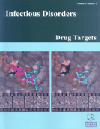- Home
- A-Z Publications
- Infectious Disorders - Drug Targets (Formerly Current Drug Targets - Infectious Disorders)
- Previous Issues
- Volume 24, Issue 5, 2024
Infectious Disorders - Drug Targets (Formerly Current Drug Targets - Infectious Disorders) - Volume 24, Issue 5, 2024
Volume 24, Issue 5, 2024
-
-
Leptospirosis Associated Digital Gangrene of Lower Extremities: Two Cases and Review of Literature
More LessAuthors: Anju Dinkar, Jitendra Singh and Mahima YadavBackground: Leptospirosis is the most common zoonotic illness worldwide, caused by pathogenic spirochete bacteria called Leptospirosis. It is clinically presented with mild to moderate in most cases. However, sometimes, the course may be severe with multiorgan dysfunction. Case Presentation: We present two rare cases of Leptospirosis with peripheral dry gangrene of the lower extremities. A 25-year-old male, far Read More
-
-
-
Ameliorating Gonorrhea: Recent Therapeutic Adaptations and Scope to Improve its Prevailing Condition
More LessAuthors: Munyaradzi Amon Bishi, Palwinder Kaur, Manish Vyas and Sandeep SharmaBackground: Gonorrhea is a sexually transmitted infection (STI) caused by the bacteria Neisseria gonorrhoeae. According to recent research, the prevalence of gonorrhea has been increasing in many parts of the world, with some areas reporting high rates of antibiotic resistance. In the United States, the Centers for Disease Control and Prevention (CDC) reported that the number of reported gonorrhea cases increased b Read More
-
-
-
Mycobacterium flavescens Infection - An Unusual Case of Prosthetic Joint Infection
More LessAuthors: Peter Holleb, Srijisnu De and Suresh AntonyIntroduction: The onset of prosthetic joint infections (PJIs) is characterized by early onset defined as within 90 days of the procedure, delayed onset defined as within 3 to 12 months, and late onset defined as over 12 months. In only a scant number of case reports, Mycobacterium flavescens associated infections are typically found in sputum cultures and associated with various forms of penetrating joint traumas, particularly Read More
-
-
-
Exosomes: Friends or Foes in Microbial Infections?
More LessAuthors: Samane Teymouri, Maryam Pourhajibagher and Abbas BahadorThe use of new approaches is necessary to address the global issue of infections caused by drug-resistant pathogens. Antimicrobial photodynamic therapy (aPDT) is a promising approach that reduces the emergence of drug resistance, and no resistance has been reported thus far. APDT involves using a photosensitizer (PS), a light source, and oxygen. The mechanism of aPDT is that a specific wavelength of light is directe Read More
-
-
-
Different Strategies Targeting Gut Microbiota for the Management of Several Disorders: A Sustainable Approach
More LessAuthors: Mahima Chowdhury, Neil Raj Chaudhary, Paranjeet Kaur, Anju Goyal and Sanjeev Kumar SahuBackground: A potential limelight is flashed on the Gut Microbiota (GM) in the human body, which confers additional psychological as well as physiological attributes to health. Other than just occupying a wide portion of the gastrointestinal tract, it also plays numerous functions in the systems of the body. Gut Microbiota is largely responsible for a considerably vast array of conditions such as obesity, diabetes ,other me Read More
-
-
-
Cracking the Code of Lumpy Skin Disease: Identifying Causes, Symptoms and Treatment Options for Livestock Farmers
More LessThe novel bovine viral infection known as lumpy skin disease is common in most African and Middle Eastern countries, with a significant likelihood of disease transfer to Asia and Europe. Recent rapid disease spread in formerly disease-free zones highlights the need of understanding disease limits and distribution mechanisms. Capripox virus, the causal agent, may also cause sheeppox and Goatpox. Even though the virus is expelled Read More
-
-
-
Efficacy and Prolonged Safety of Haemophilus influenzae Type b Conjugate Vaccines
More LessAuthors: Nishita Tripathi and Sayali MukherjeeObjective: The purpose of this study was to find data proving the influence of the Haemophilus influenzae type b (Hib) conjugate vaccination on the frequency of invasive Hib illness. Methodology: A systematic literature search was conducted on the PubMed database to identify peerreviewed publications pertaining to the epidemiology of Haemophilus influenzae meningitis, both before and after the introduction of Haemophilu Read More
-
Volumes & issues
-
Volume 25 (2025)
-
Volume 24 (2024)
-
Volume 23 (2023)
-
Volume 22 (2022)
-
Volume 21 (2021)
-
Volume 20 (2020)
-
Volume 19 (2019)
-
Volume 18 (2018)
-
Volume 17 (2017)
-
Volume 16 (2016)
-
Volume 15 (2015)
-
Volume 14 (2014)
-
Volume 13 (2013)
-
Volume 12 (2012)
-
Volume 11 (2011)
-
Volume 10 (2010)
-
Volume 9 (2009)
-
Volume 8 (2008)
-
Volume 7 (2007)
-
Volume 6 (2006)
Most Read This Month
Article
content/journals/iddt
Journal
10
5
false
en


